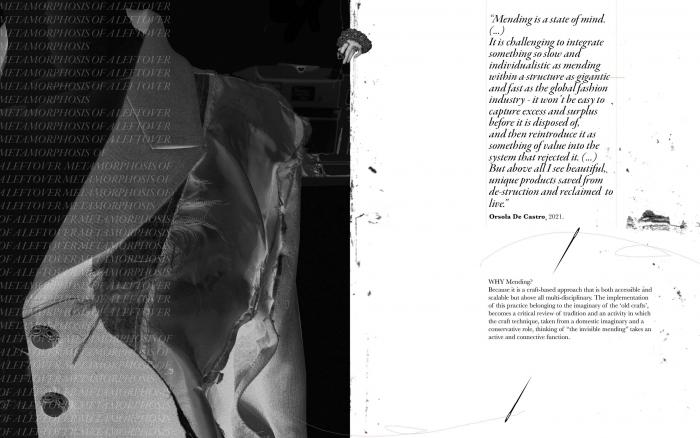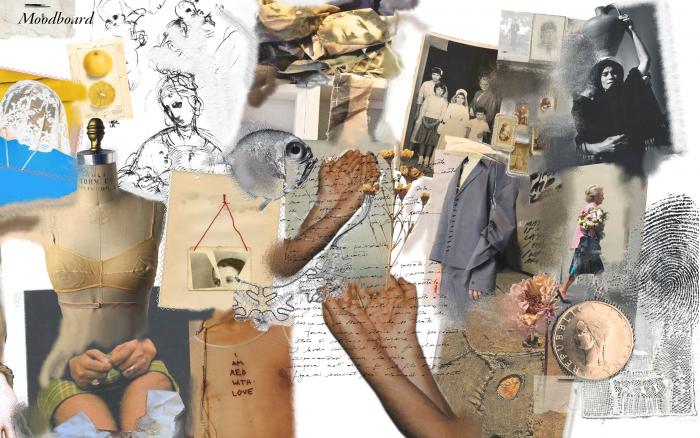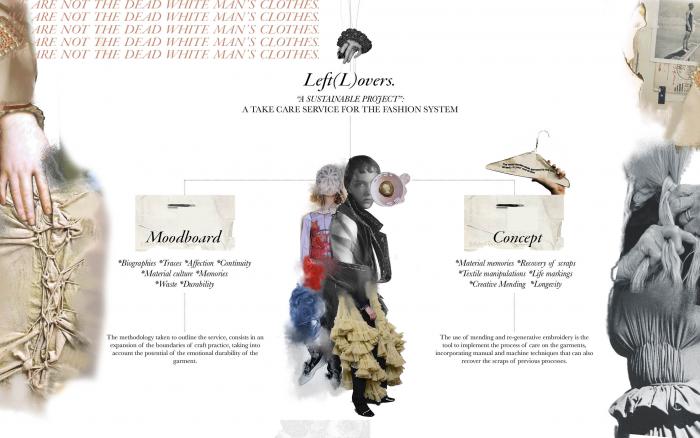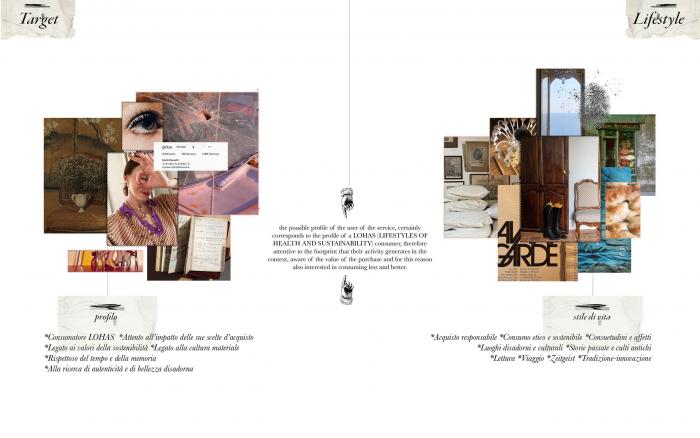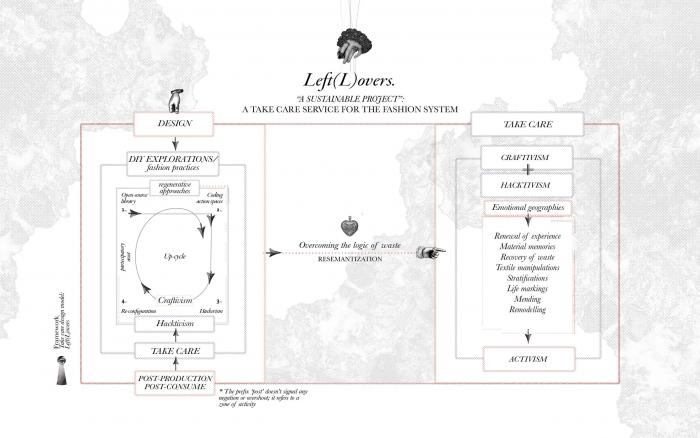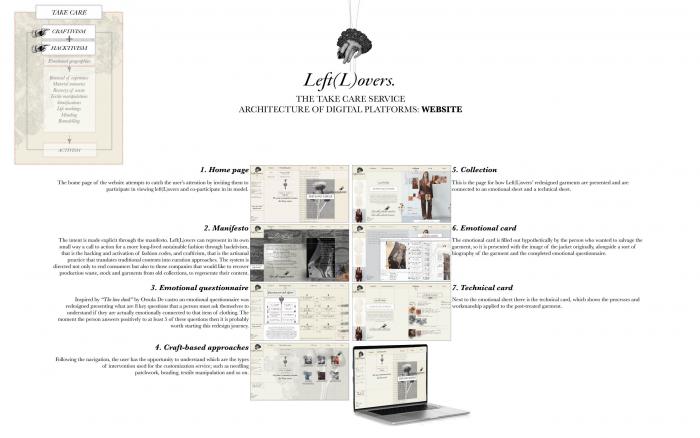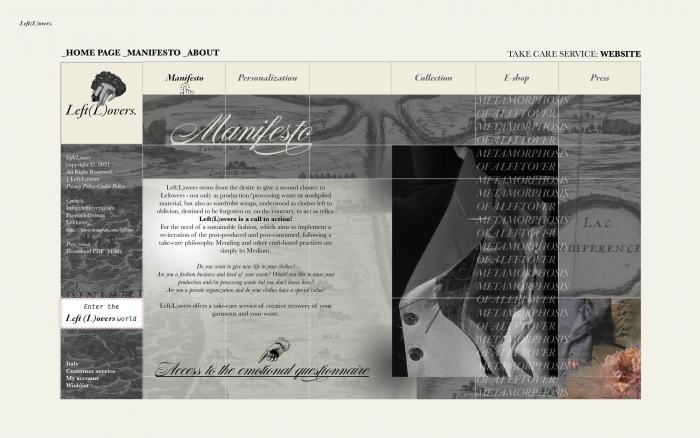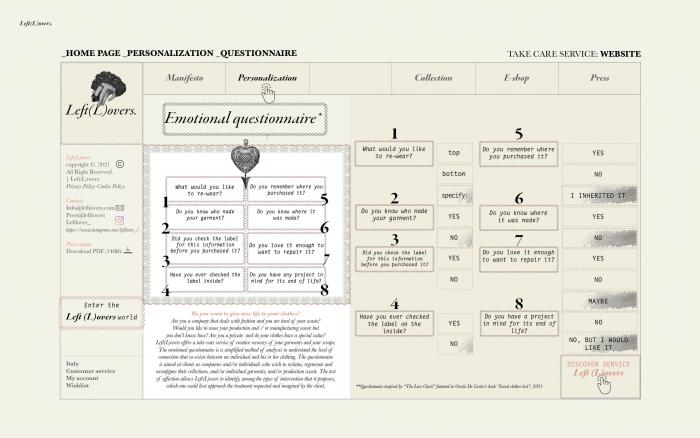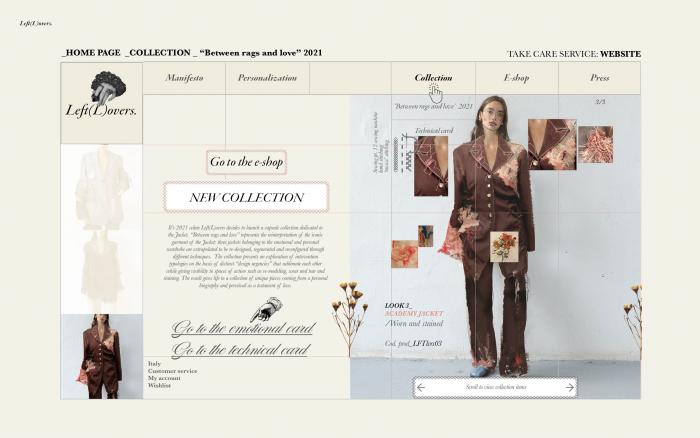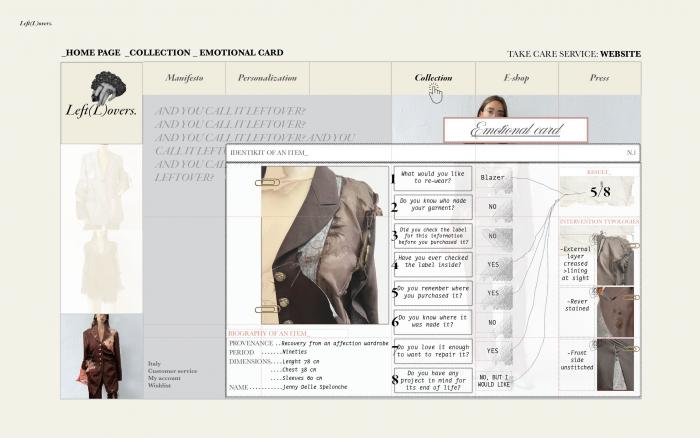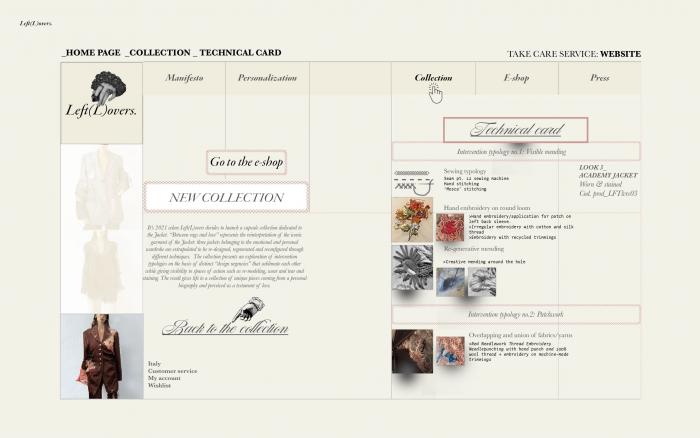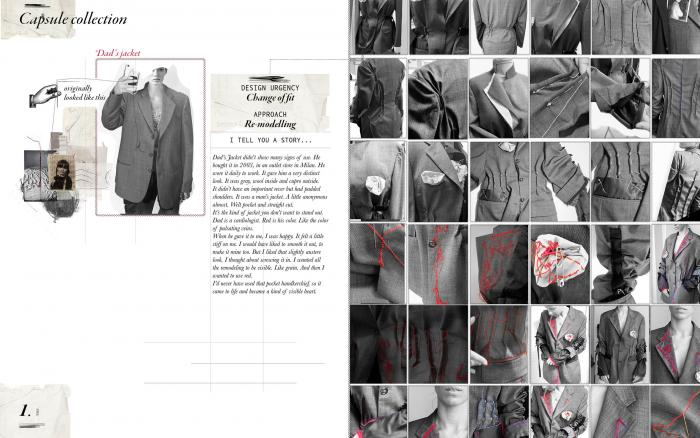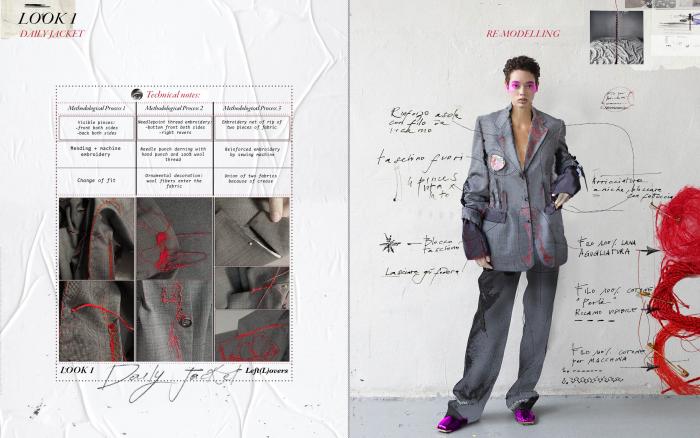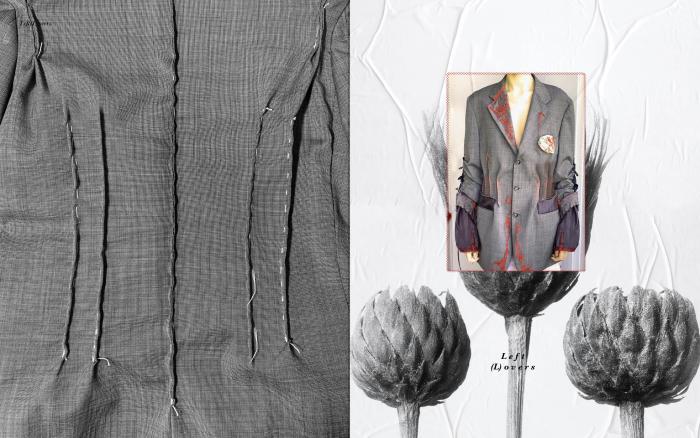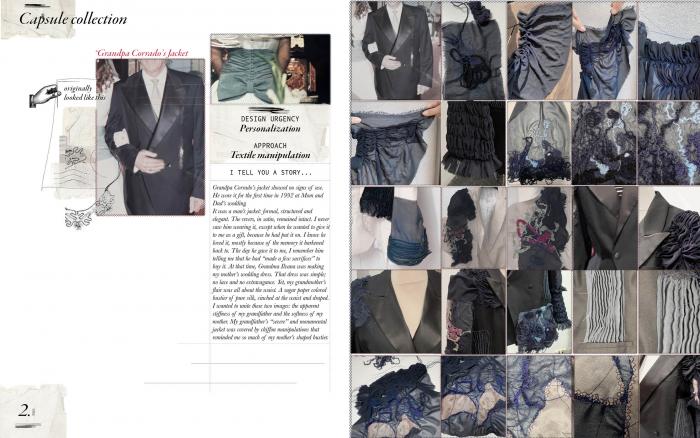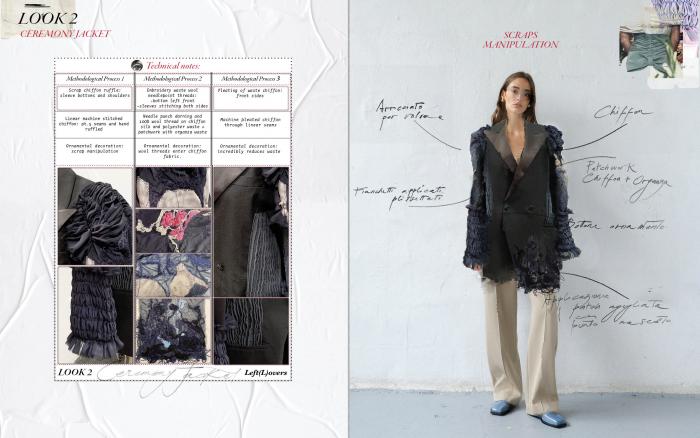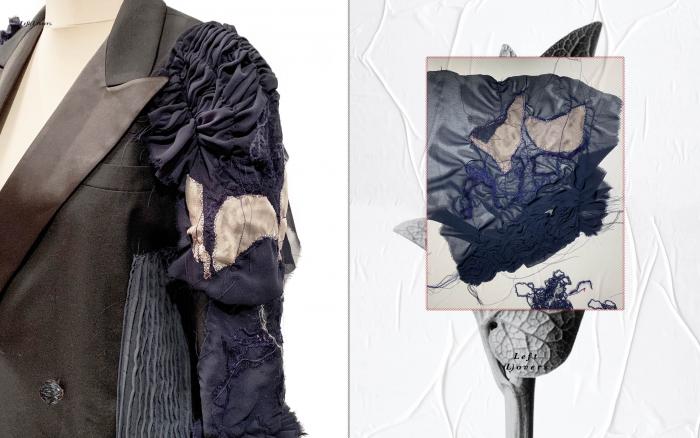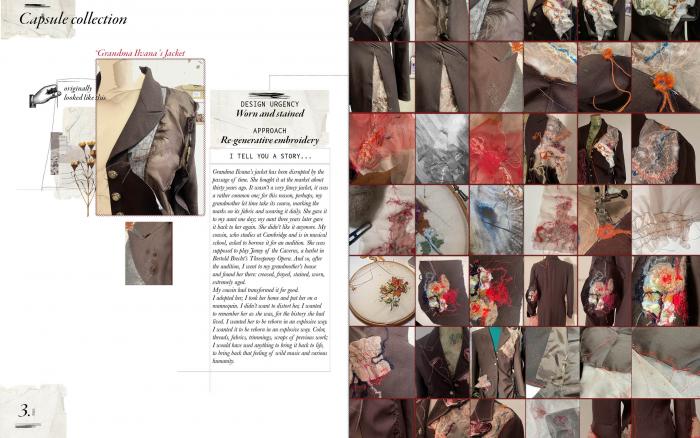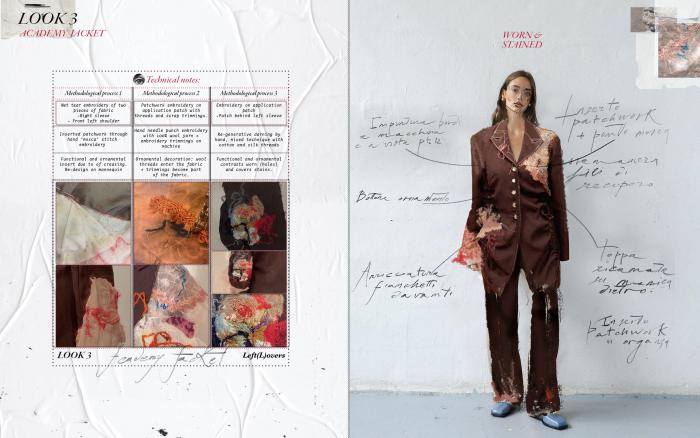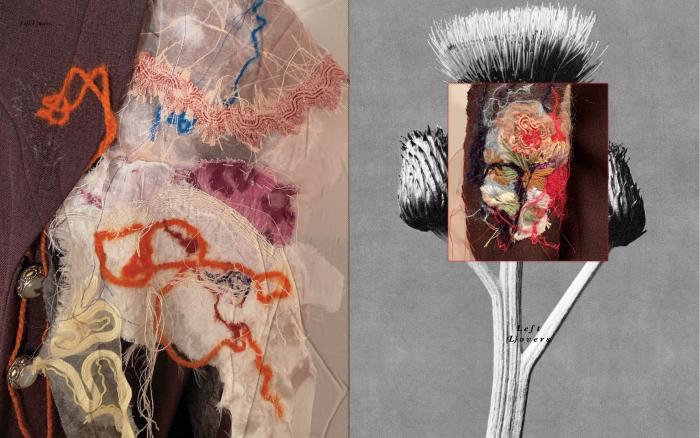I. SUMMARY INFORMATION
Project
267733
Status
Submitted
Award category
Products and life style
You want to submit
NEW EUROPEAN BAUHAUS RISING STARS : concepts or ideas submitted by young talents (aged 30 or less)
Project title
Left(L)overs
Full concept/idea title
a resemantization and a re-configuration of waste in the Fashion System
Description
Born as a thesis project, Left(L)over is a true Call to Action for a more sustainable fashion. It is a system that is configured in a take-care service operating on pre-loved clothing through craftivism operations; It uses re-generative mending and other craft-based approaches to implement the process of care on the garments. Left(L)overs incorporates both manual techniques and machine work to recover the leftovers of used garments taking into account the emotional connection with clothing.
Where is your concept/idea being developed or intended to be implemented in the EU?
Italy
Milano
via antonio maffi, 13
45.46342
9.19405
milano
20162
II. DESCRIPTION OF THE PROJECT
Please provide a summary of your concept/ idea
Born as a thesis project, Left(L)over is a true Call to Action for a more sustainable fashion. It is a system that is configured in a take-care service operating on pre-loved clothing through craftivism operations; It uses re-generative mending and other craft-based approaches to implement the process of care on the garments. Left(L)overs incorporates both manual techniques and machine work to recover the leftovers of used garments taking into account the emotional connection with clothing.
Take-care is therefore a sustainable design solution able to revitalize an item destined for disposal. What are commonly defined as "defects" can become added values. To this end, the designer investigates some typologies of intervention related to the 'practices of thread', applying this model to three specific cases: worn, stain and remodelling. The artisanal approaches, with a strong design-oriented vision, express a philosophy of care entrusted to the slowness of the intimate manual gesture, remaining extraneous to the mutable logic of fashion. Thanks to this regenerating power, the design gesture of mending can only enhance the wefts of the past from which today we can recover the waste, the fragmented memories.
Today, mending acquires for society the polysemic value of a collective and individual therapy through that incessant practice of hybridization and re-iteration of cultural and material heritage.
From this investigation, the Take-care service Left(L)over is born.
Please give information about the key objectives of your concept/idea in terms of sustainability and how these would be met
The linear economy model within the fashion industry has demonstrated a general tendency towards overproduction and overconsume that feeds the "logic of waste". The latter has taken the form of human, cultural and environmental exploitation that has required a change in operating models.
In pre-industrial societies there was a similar concept to waste that corresponded to the concept of shard, remainder. Resources, objects and clothes were used and transformed by the passage of time, which caused worn and tear until the items were discarded.Thus things aged and died in imitation of a natural cycle. Today the concept of waste, scrap or leftover, has inevitably evolved and has become a constant presence, falling into a very precise category.Already from the definition it is clear that everything that is considered waste is determined as such, starting from a subjective qualitative assessment. Today it is necessary that its paradigms can be reformulated.
Restarting from the four pillars of sustainability, Left(L)overs investigates the concept of waste, discard and surplus in the fashion industry in order to resemantize and reconfigure it within the system. In 2017, the Montreal Declaration emphasized that the figure of the designer plays a central role, not only in the product creation process, but also in educating consumers on the values of social, cultural, environmental and economic sustainability.
Left(L)overs is therefore a design-based service that with a vision of care seeks to map out sustainable and long-lived trajectories to remedy the early disposal of clothing. In terms of Sustainability, Left(L)overs contrasts the linear model buy-throwaway, enhancing and re-generating the emotional attachment user-product.
Please give information about the key objectives of your concept/idea in terms of aesthetics and quality of experience beyond functionality and how these would be met
Among the design tools capable of tracing forward-looking trajectories, 'take-care' emerges as a practice of personalization and customization from an emotional point of view.
Left(L)overs seeks to give selected garments a sophisticated look and appeal. Precisely because all garments come from a biography, from fragmented memories that can be relived and renewed through the practice of hybridization of material heritage. Traditional approaches are used experimentally on clothing in order to create visually innovative dialogues between tradition and modernity, past and present.The renewal of experience is emphasized according to the zeitgeist without betraying the roots, but rather in continuity with them. The methodology undertaken to delineate the service, consists of an expansion of the craft practice, taking into account the emotional durability of the item.
The use of mending and regenerative embroidery is the ultimate tool to implement the process of care on the garments, incorporating manual and machine techniques capable of recovering even the waste of previous processing. Even defects and signs of consumption regain appeal, according to a design philosophy very close to the Japanese tradition. In the one-to-one relationship between designer and user, stands the added value of the Left(L)overs service.
It’s 2021 when Left(L)overs decides to launch her first capsule collection dedicated to the Jacket. “Between rags and love” represents the reinterpretation of the iconic garment of the Jacket: three jackets belonging to the personal wardrobe are meant to be re-designed. The collection presents an exploration of intervention typologies on the basis of distinct “design urgencies” that sublimate each other while giving visibility to spaces of action such as re-modeling, worn and stain. The result gives life to a collection of unique pieces perceived as a testament of love.
Please give information about the key objectives of your concept/idea in terms of inclusion and how these would be been met
In terms of Inclusion Left(L)overs is conceived as a participatory model. The main purpose of the website is to attract the user to join the Left(L)overs world; one of the first interfaces that appear on the portal is in fact the presentation of an emotional questionnaire, which is preliminary to the function of the service.
Freely inspired to "the love check" by Orsola De castro: the interactive questionnaire presents eight key questions that must be hypothetically filled in by the user of the service in order to enable him/her and Left(L)overs to understand how much the person is actually emotionally attached to that item of clothing.
The moment the user answers positively to at least 5 of these questions then Left(L)overs examines the specific case and considers undertaking the journey of redesigning the garment.The emotional questionnaire is a simplified method of analysis to understand the level of connection that co-exists between an individual and his/her clothing. The questionnaire is aimed at clients as companies and/or individuals who wish to recovery, regenerate and reconfigure their collections, and/or individual garments, and/or production waste. The test of affection allows Left(L)overs to identify, among the types of intervention that it proposes, which one could best approach the treatment requested and imagined by the client. Left(L)overs is a definitely inclusive model as it consists of a participatory and open-source format for the fashion system.
The further innovative character is the way in which the Instagram account is used; it does not act as a traditional tool for promoting the service (for that there is already the website), but rather it communicates processes, methodologies and offers insights for change of point of view. It’s an inspirational page related to the call to action theme. The goal to be effectively sustainable is to involve other designers and change their way of seeing fashion in contemporary times.
Please explain the innovative character of your concept/ idea
Left(L)overs is an innovative concept because it born from the urge of a contemporary designer to respond to the needs of his time. The contemporary designer corresponds to an activist, hacktivist and craftivist profile that bases the creation of value on the pillars of sustainable development. The pioneers of this philosophy were undoubtedly Otto Von Busch and Orsola De Castro, who contributed significantly to the development of this project. Left(L)overs is a revolutionary system because it considers sustainability not only as a modus operandi for producing new design solutions but, within the fashion industry, it can be a synonym for innovative operative models. In particular, Left(L)overs proposes a sustainable model that fulfils the paradigm of 'consume less and better'. This service works on post-produced and post-consumed clothing in order to reduces consumption waste, raise awareness and activate the take-care culture. The intimate and personal geography gives rise to a decoded model that translates the individual value on a collective and universally valid level. Today, in fact, craft-based approaches such as mending acquires for society the polysemic value of a therapy. A sustainable gesture of care. Finally Left(L)overs, not only can offer a service to customers who wish to regenerate their garments according to specific needs, but can also offer a service based on the designer's choice of pre-loved clothes from vintage shops, second-hand, personal wardrobes, wardrobes of friends and relatives and so on. Consequently then, the final consumer will be the one who also 'adopts the garment'.
The possible user of the service corresponds to a LOHAS (Lifestyle of Health and Sustainability) consumer, who is therefore attentive to the footprint that his or her activity generates in the context, aware of the value of the purchase and therefore also interested in consuming less and better.
Please detail the plans you have for the further development, promotion and/or implementation of your concept/idea, with a particular attention to the initiatives to be taken before May 2022
As a first step, Left(L)overs aims to develop the website in detail as an open access platform and service. Primarly, the application for filling in the head's emotional card.
As a second step, Left(L)overs aims to expand its network through the targeted use of social networks in order to educate its community but also building stronger aggregations among designers who believe in the sustainable development of the fashion sector.
Encouraging a take-care culture by enhancing emotional connections with owned clothes and combating early obsolescence and disaffection, typical expressions of the cradle-to-grave paradigm of the linear economy through the practice of traditional practices translated into caring approaches.
Building a real system for the creation of unique pieces, going beyond the traditional concept of seasonal trends but regenerating garments taking into account personal biography of the owners.
Offering a selection of items curated by the design collective
Entering into partnerships with sewing cooperatives
Propose subsidiary collections for fashion brands that want to reduce manufacturing waste, recover defective garments, reuse sample fabrics, or simply want specific processes that reuse production waste and craft-based techniques such as regenerative embroidery and darning.
Promoting and activating a series of lectures and workshops with the focus on sustainable practices such as care-approaches that Left(L)overs choose to use in both physical and digital education.
Sharing tutorials for a DIY best practice.
Actively collaborating to outline a new future scenario in the fashion system that is ethically sustainable and also respects the production of excellence typical of the made in Italy heritage.
III. UPLOAD PICTURES
IV. VALIDATION
By ticking this box, you declare that all the information provided in this form is factually correct, that the proposed concept/idea has not been proposed for the New European Bauhaus Rising Stars Awards more than once in the same category.
Yes
